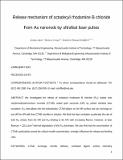Release mechanism of octadecyl rhodamine B chloride from Au nanorods by ultrafast laser pulses
Author(s)
Alper, Joshua; Crespo, Monica P.; Hamad-Schifferli, Kimberly
DownloadMain article (295.9Kb)
OPEN_ACCESS_POLICY
Open Access Policy
Creative Commons Attribution-Noncommercial-Share Alike
Terms of use
Metadata
Show full item recordAbstract
We investigated the release of octadecyl rhodamine B chloride (R[subscript 18]) loaded onto cetyltrimethylammonium bromide (CTAB) coated gold nanorods (NR) by pulsed ultrafast laser excitation. R[subscript 18] intercalates into the hydrophobic CTAB bilayer on the NR surface and can exchange on and off the NR with free CTAB micelles in solution. We find that laser excitation accelerates the rate of both R[subscript 18] release from the NR and R[subscript 18] binding to the NR with increasing fluence. However, at laser fluences >220 μJ/cm[superscript 2] thermal degradation of the R[subscript 18] dominates. We also find that the concentration of CTAB, particularly around the critical micelle concentration, strongly influences the release and binding rates.
Date issued
2009-04Department
Massachusetts Institute of Technology. Department of Biological Engineering; Massachusetts Institute of Technology. Department of Mechanical EngineeringJournal
Journal of Physical Chemistry C
Publisher
American Chemical Society
Citation
Alper, Joshua, Monica Crespo, and Kimberly Hamad-Schifferli. “Release Mechanism of Octadecyl Rhodamine B Chloride from Au Nanorods by Ultrafast Laser Pulses.” The Journal of Physical Chemistry C 113.15 (2009): 5967-5973.
Version: Author's final manuscript
ISSN
1932-7447